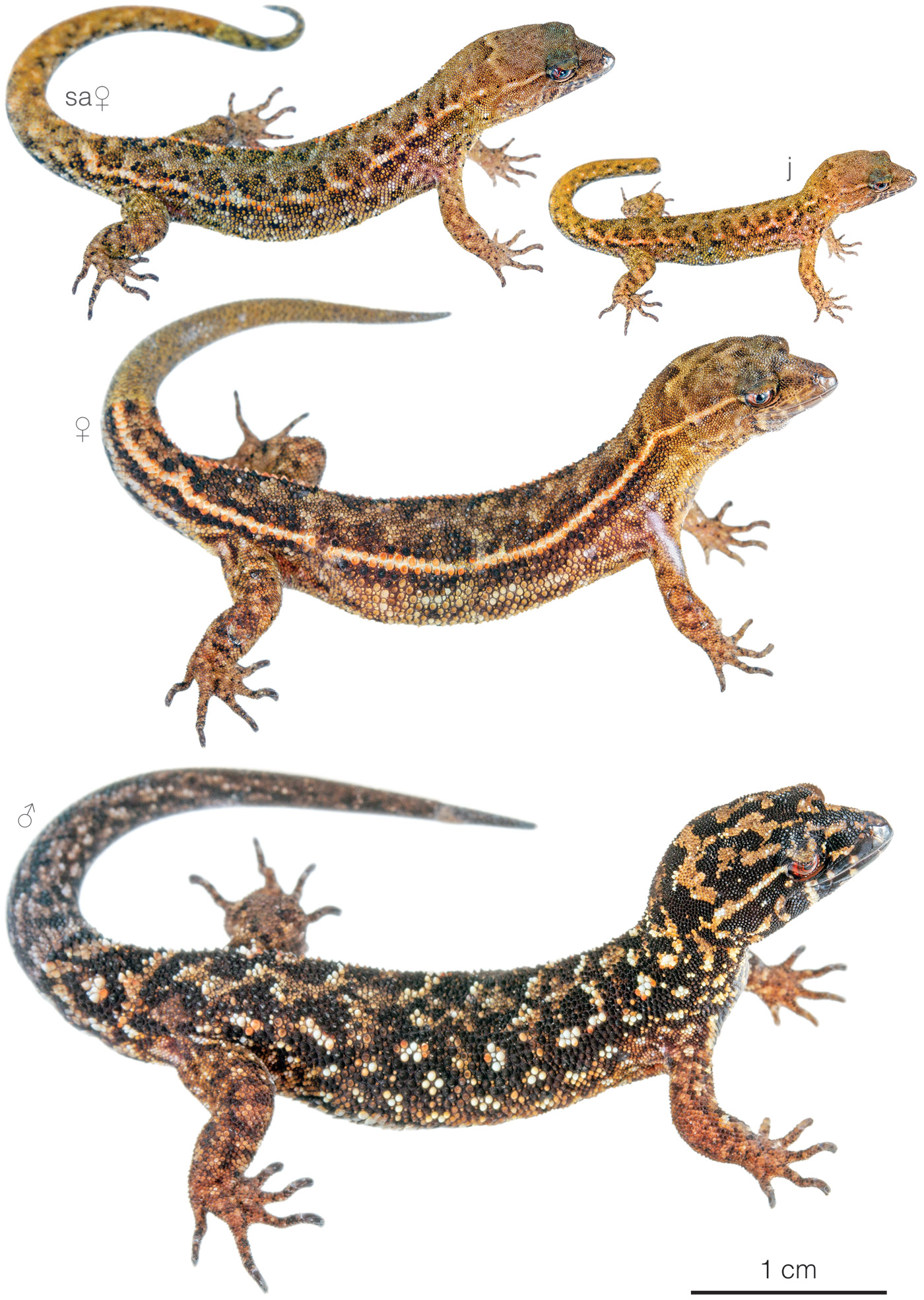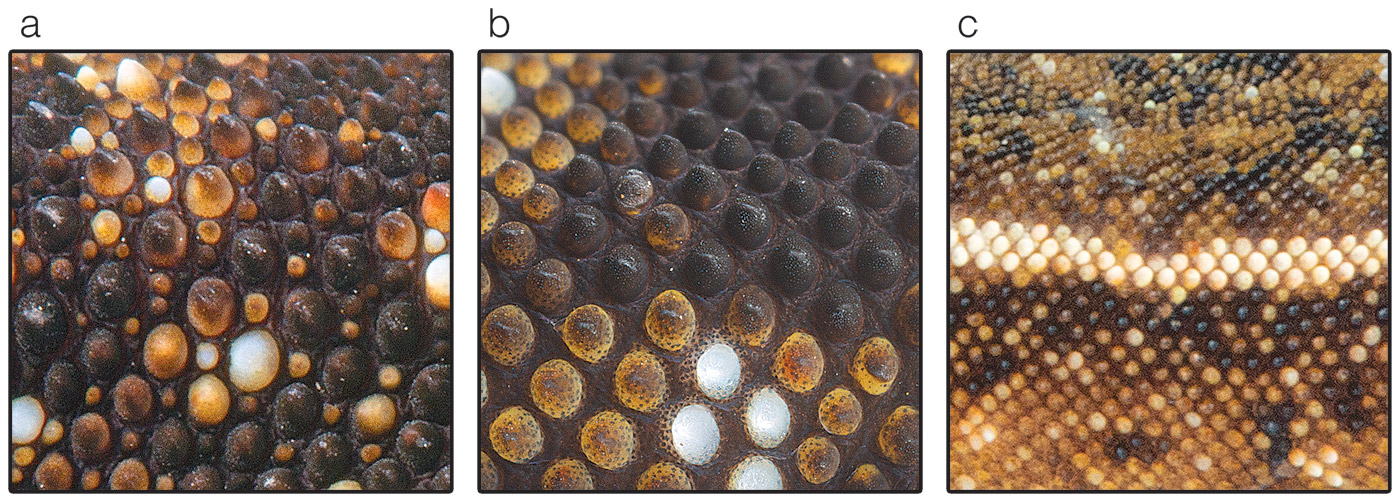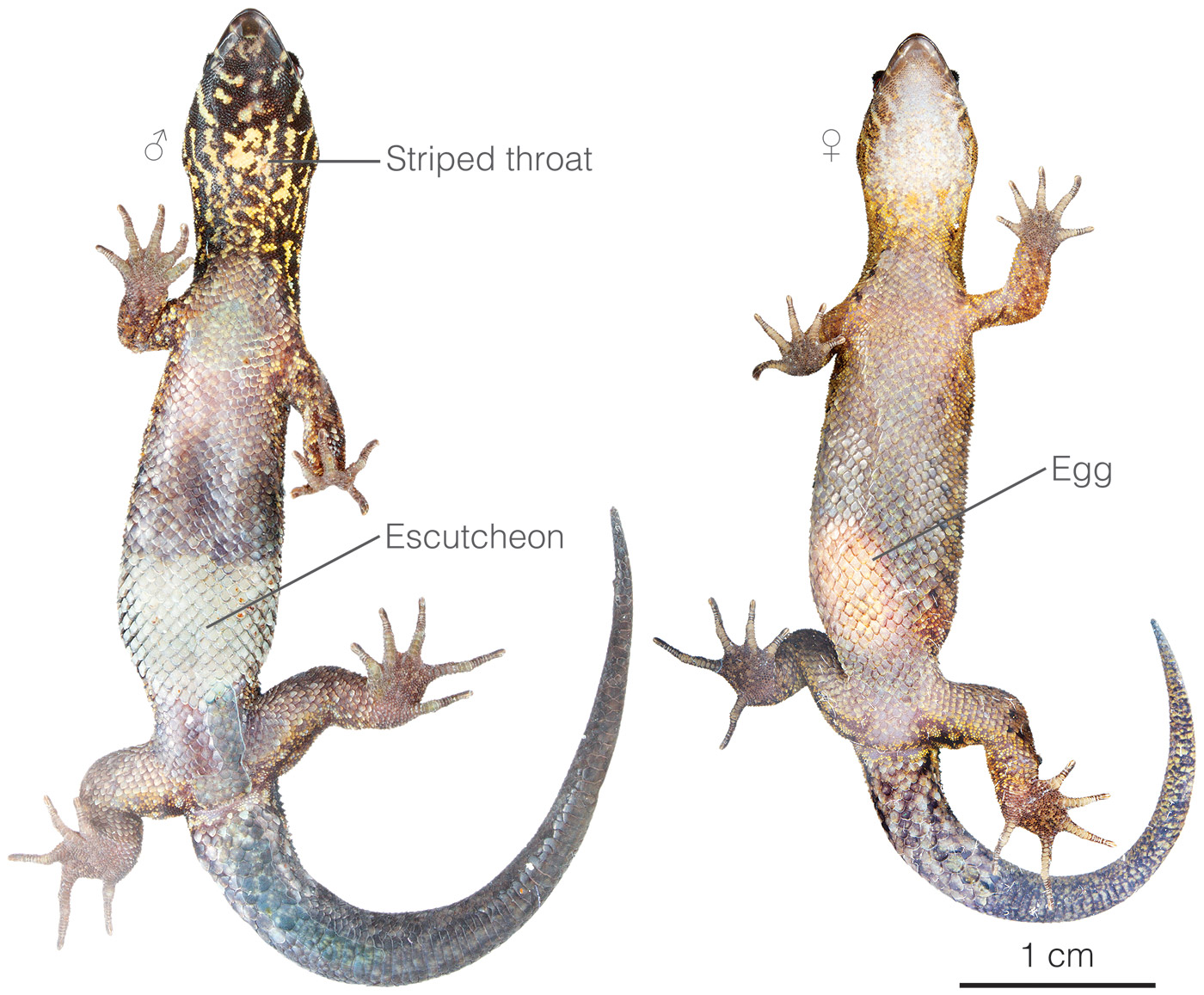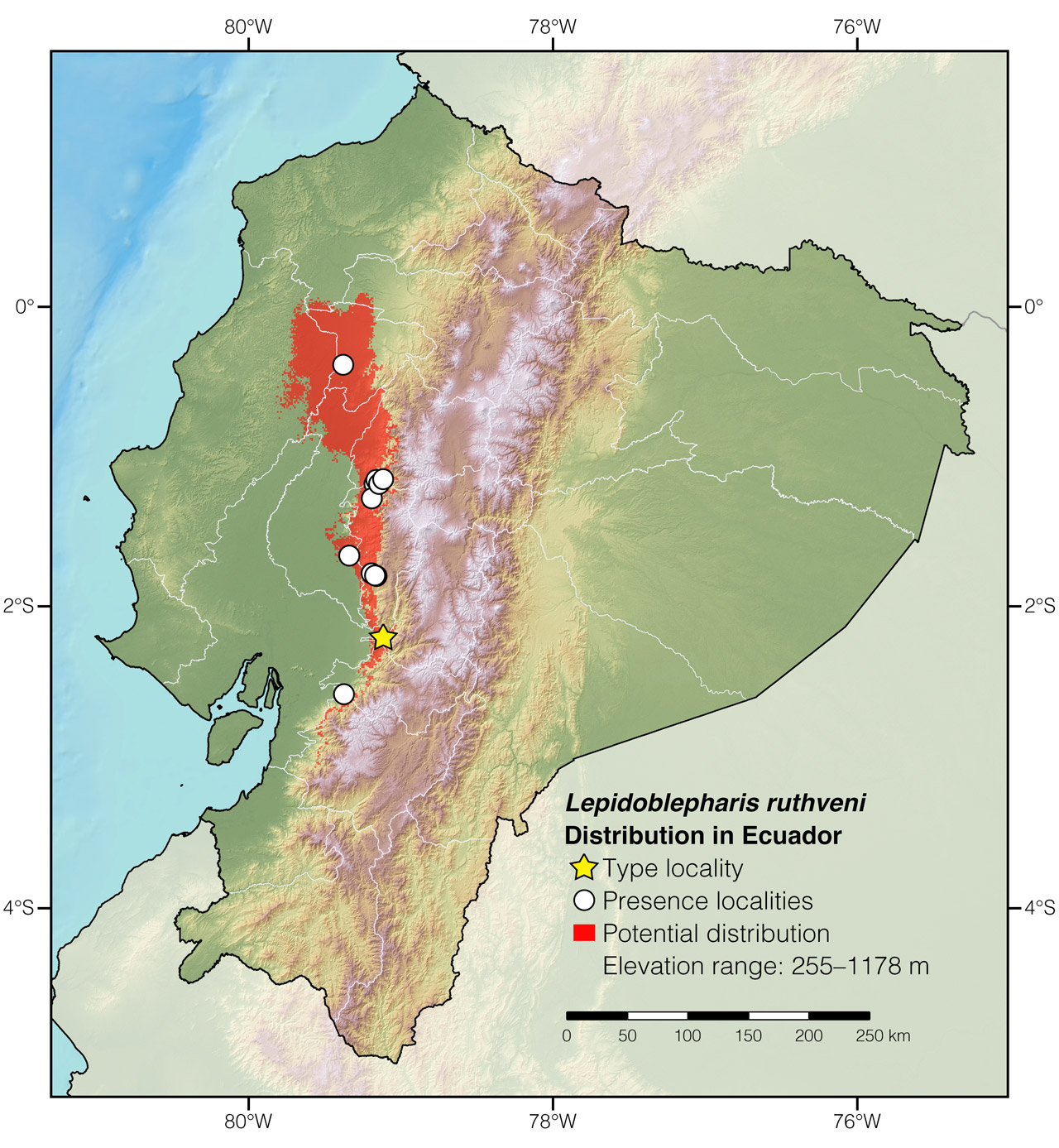Published February 29, 2021. Updated January 10, 2024. Open access. | Purchase book ❯ |
Roughskin Dwarf-Gecko (Lepidoblepharis ruthveni)
Reptiles of Ecuador | Sauria | Sphaerodactylidae | Lepidoblepharis ruthveni
English common names: Roughskin Dwarf-Gecko, Ruthven’s Scaly-eyed Gecko.
Spanish common names: Hojarito áspero, geco áspero de pestañas.
Recognition: ♂♂ 11.2 cmMaximum distance from the snout to the tip of the tail. Snout–vent length=5.1 cm. ♀♀ 10.7 cmMaximum distance from the snout to the tip of the tail. Snout–vent length=4.9 cm.. Dwarf geckos differ from other lizards based on their small size, lack of movable eyelids, presence of a scaly supraciliary flap, and their leaf-litter-dwelling habits.1,2 The Roughskin Dwarf-Gecko (Lepidoblepharis ruthveni) differs from other members of its genus occurring in the Ecuadorian Chocó rainforest by being larger in body size and having conspicuously heterogeneous dorsal scales: tiny granules interspersed with large conical scales (Figs 1 and 2).3,4 This species could be confused with L. conolepis and L. grandis, but these other geckos have sub-equal (mostly homogeneous) conical dorsal scales3,5 and occur north of the known distribution of L. ruthveni. Males of L. ruthveni differ from females by having a silver escutcheon, a characteristic concentration of holocrine secretory glands, on the belly (Fig. 3).5

Figure 1: Individuals of Lepidoblepharis ruthveni from Balzapamba, Bolívar province, Ecuador. sa=subadult, j=juvenile.

Figure 2: Differences in dorsal scale arrangements among Lepidoblepharis occurring in western Ecuador: (a) tiny granules interspersed with large conical scales in L. ruthveni; (b) homogeneous large conical scales in L. conolepis and L. grandis; and (c) small homogeneous granular scales in L. buchwaldi, L. intermedius, and L. peraccae.

Figure 3: Key morphological differences of the ventral aspect of adult males and females of Lepidoblepharis ruthveni.
Natural history: Lepidoblepharis ruthveni is a terrestrial and diurnal lizard that inhabits old-growth to heavily-disturbed rainforests, lower evergreen montane forests, and banana and cacao plantations adjacent to these forests.6 Roughskin Dwarf-Geckos are cryptozoic, spending most of their lives in thick accumulations of damp leaf-litter in well-shaded habitats along streams. When not active, they hide in crevices, holes in the ground, under rocks, logs, or piles of leaves.6 When threatened, individuals of L. ruthveni will quickly flee under cover. If captured, they can readily shed the tail as well as portions of their skin.6
Conservation: Vulnerable Considered to be facing a high risk of extinction in the mid-term future.. Lepidoblepharis ruthveni is proposed to be listed in this category, instead of Least Concern,7 on the basis of the species’ limited extent of occurrence (here estimated to be ~10,326 km2) in an area having the highest rate of deforestation in Ecuador.8 An estimated 89% of the total suitable habitat of L. ruthveni has already been converted to pastures and agricultural fields,8 an environment in which the species does not survive. Furthermore, L. ruthveni has not been recorded in any of Ecuador’s national parks.
Distribution: Lepidoblepharis ruthveni is endemic to an area of approximately 10,326 km2 in the Chocoan lowlands and adjacent foothills of the Andes in west-central Ecuador (Fig. 4). Records of this species from northwestern Ecuador and western Colombia are likely based on misidentifications.

Figure 4: Distribution of Lepidoblepharis ruthveni in Ecuador. See Appendix 1 for a complete list of the presence localities included in the map.
Etymology: The generic name Lepidoblepharis comes from the Greek words lepidos (=scale) and blepharis (=eyelash),9 and refers to the scaly supraciliary flaps.10 The specific epithet ruthveni honors Alexander Grant Ruthven (1882–1971), former president of the University of Michigan, in recognition of his innumerable contributions to the herpetology of the Americas.11
See it in the wild: Roughskin Dwarf-Geckos are secretive lizards that are recorded rarely unless they are actively searched for by raking leaf-litter or by turning over rotten logs along forested streams. Individuals can be found at a rate of 0–4 individuals per day of sampling in gallery forests near the towns of Moraspungo, Balzapamba, and Bucay.
Acknowledgments: Special thanks to María Jose Quiroz and Eric Osterman for finding some of the individuals of Lepidoblepharis ruthveni photographed in this account. This account was published with the support of Secretaría Nacional de Educación Superior Ciencia y Tecnología (programa INEDITA; project: Respuestas a la crisis de biodiversidad: la descripción de especies como herramienta de conservación; No 00110378), Programa de las Naciones Unidas (PNUD), and Universidad San Francisco de Quito (USFQ).
Author: Alejandro ArteagaaAffiliation: Fundación Khamai, Reserva Arlequín, Ecoruta Paseo del Quinde km 56, Santa Rosa de Mindo, Pichincha 171202, Ecuador.
Photographer: Alejandro ArteagaaAffiliation: Fundación Khamai, Reserva Arlequín, Ecoruta Paseo del Quinde km 56, Santa Rosa de Mindo, Pichincha 171202, Ecuador.
How to cite? Arteaga A (2024) Roughskin Dwarf-Gecko (Lepidoblepharis ruthveni). In: Arteaga A, Bustamante L, Vieira J (Eds) Reptiles of Ecuador: Life in the middle of the world. Available from: www.reptilesofecuador.com. DOI: 10.47051/VRQC6675
Literature cited:
- Peters JA, Donoso-Barros R (1970) Catalogue of the Neotropical Squamata: part II, lizards and amphisbaenians. Bulletin of the United States National Museum, Washington, D.C., 293 pp.
- Batista A, Ponce M, Vesely M, Mebert K, Hertz A, Köhler G, Carrizo A, Lotzkat S (2015) Revision of the genus Lepidoblepharis (Reptilia: Squamata: Sphaerodactylidae) in Central America, with the description of three new species. Zootaxa 3994: 187–221. DOI: 10.11646/zootaxa.3994.2.2
- Miyata K (1985) A new Lepidoblepharis from the Pacific slope of the Ecuadorian Andes (Sauria: Gekkonidae). Herpetologica 41: 121–127.
- Parker HW (1926) The neotropical lizards of the genera Lepidoblepharis, Pseudogonatodes, Lanthrogecko, and Sphaerodactylus, with the description of a new genus. Annals and Magazine of Natural History 17: 291–301. DOI: 10.1080/00222932608633413
- Avila-Pires TCS (2001) A new species of Lepidoblepharis (Reptilia: Squamata: Gekkonidae) from Ecuador, with a redescription of Lepidoblepharis grandis Miyata, 1985. Occasional Paper of the Sam Noble Oklahoma Museum of Natural History 11: 1–11.
- Field notes, Reptiles of Ecuador book project.
- Rivas G, Cisneros-Heredia DF, Caicedo J, Gutiérrez-Cárdenas P (2015) Lepidoblepharis ruthveni. The IUCN Red List of threatened species. Available from: www.iucnredlist.org. DOI: 10.2305/IUCN.UK.2015-4.RLTS.T44579436A44579439.en
- MAE (2012) Línea base de deforestación del Ecuador continental. Ministerio del Ambiente del Ecuador, Quito, 30 pp.
- Brown RW (1956) Composition of scientific words. Smithsonian Books, Washington D.C., 882 pp.
- Peracca MG (1897) Viaggio del Dr. Enrico Festa nell'Ecuador e regioni vicine. Bolletino dei Musei di Zoologia ed Anatomia Comparata della Università di Torino 12: 1–20. DOI: 10.5962/bhl.part.4563
- Uetz P, Freed P, Hošek J (2021) The reptile database. Available from: www.reptile-database.org
Appendix 1: Locality data used to create the distribution map of Lepidoblepharis ruthveni in Ecuador (Fig. 4). Go to the section on symbols and abbreviations for a list of acronyms used.
| Country | Province | Locality | Source |
| Ecuador | Azuay | Río Patul | Field notes of Eduardo Toral |
| Ecuador | Bolívar | Balsapamba | EPN 13854; examined |
| Ecuador | Bolívar | Balsapamba, 4.15 km E of | This work; Fig. 1 |
| Ecuador | Bolívar | Border between Bolívar and Cotopaxi | Miyata 1985 |
| Ecuador | Bolívar | Pangua, 9 km SW of | Online multimedia |
| Ecuador | Bolívar | San Luis de Pambil, 7 km SE of | Online multimedia |
| Ecuador | Cotopaxi | Moraspungo, 9.1 km E of | USNM 286108; VertNet |
| Ecuador | Guayas | Chimbo | Parker 1926 |
| Ecuador | Los Ríos | Cerro Sama Mumbes | iNaturalist; photo examined |
| Ecuador | Santo Domingo de los Tsáchilas | Río Peripa | Parker 1926 |